Geoff Nicholson's Blog, page 63
November 30, 2011
WALKING WITH AND WITHOUT GHOST TRAINS
Having got this "haunted house" thing in my head, I dug out a cutting I'd kept from LA Weekly's annual "Best of LA" issue. There in the Mind and Body section was a listing for "Best Haunted Hiking," that read in part, "Where do you go when you want to see a ghost train? Corralitas Red Car Property sits on land formerly part of the Pacific Electric Streetcar line which cut through Silver Lake on its way to Glendale until it was decommissioned in 1955. Bordered on both sides by the skeletons of abandoned cars and machinery, the public trail near the old rail is as creepy as it is cool. Relics of the big red cars are still visible."
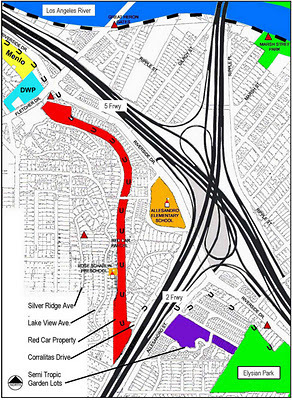
Sounded good to me. As you see from the map, the Red Car Property is a strange, bent finger of land, than runs between people's back gardens, and not really very long, less than a mile end to end. (It's the red bit, I thought it should be clickable but apparently it's not. Blogger eh?) There have been various attempts to redevelop it, including a plan to build new houses there. LA is, of course, the home of the impossible real estate plot, but even so it's hard to imagine how that would work, the land in the corridor is more or less flat but it rises sharply on one side, drops sharply on the other, there wouldn't see to be room for both houses and an access road. In any case, so far it's come to nothing.

I know bits of Silver Lake reasonably well, but not this part. I used the map and information from a website named www.modernhiker.com. I gained access at the corner of Alessandro Way and Lake View Avenue, right opposite the Holyland Exhibition which alas was closed when I was there.
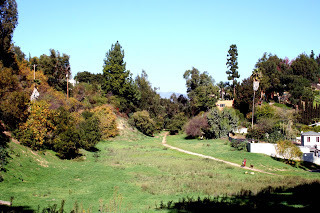
Initially the route runs alongside a chain link fence above the freeway, then widens out into open land, a desire line running across the middle, before narrowing again, and remaining unpaved as it takes you between people's houses and back yards. This land isn't public, and it certainly doesn't belong to the properties that line it, but as is the human way, the locals have spread themselves, encroached, extended their gardens, parked multiple cars and trucks on the land. Someone seems to have made a shrine to a dead pet, at least one hopes it's a pet. And nature has played is part too: there are escapee yuccas and cacti cascading down the hillsides.
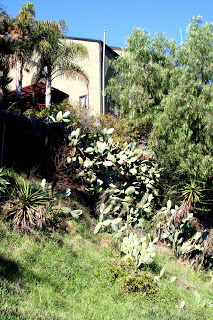
In various places as you walk along you can see multiple main roads, you're in sight and loud earshot of the freeways, and you can see mountains and indeed Forest Lawn cemetery in the distance. It's a very LA landscape at certain points, at others it feels like you could be in rural Arkansas.
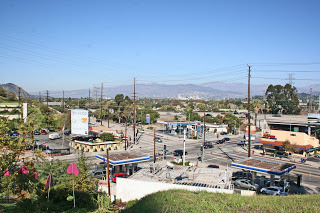
Like I said, it isn't a very long walk, there and back is just a couple of miles, although it's easy enough to extend it in various directions. Journey's end, such as it is, is an arrangement of concrete blocks set on a hillside above Riverside Drive. I have read that these are known as the Stonehenge of LA, but I'm not sure to whom. In fact this City of Los Angeles Historic Landmark # 770, and the concrete blocks were once the footings of the Pacific Electric Red Car Viaduct.
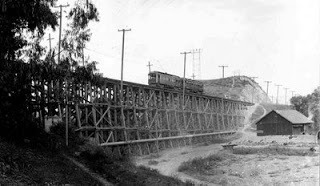
A website called http://redcarproperty.blogspot.com/ has pictures of the Red Car line, including the viaduct (above), but it takes a pretty enormous feat of the imagination to picture exactly how this fits with the current topography. As you see, at the time I was there someone was using the footings as bases for art works.
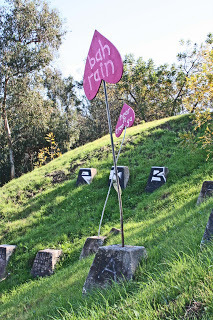
As for the haunted hiking, the ghost train, the skeletons of abandoned cars and machinery, the relics of the big red cars – I didn't see a damn thing. Maybe I was distracted or unobservant or preoccupied, but I suppose it's in the nature of ghosts that they only show themselves to certain people.
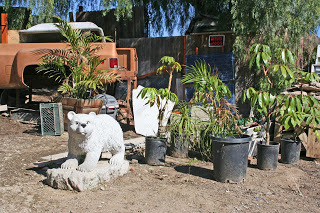



Sounded good to me. As you see from the map, the Red Car Property is a strange, bent finger of land, than runs between people's back gardens, and not really very long, less than a mile end to end. (It's the red bit, I thought it should be clickable but apparently it's not. Blogger eh?) There have been various attempts to redevelop it, including a plan to build new houses there. LA is, of course, the home of the impossible real estate plot, but even so it's hard to imagine how that would work, the land in the corridor is more or less flat but it rises sharply on one side, drops sharply on the other, there wouldn't see to be room for both houses and an access road. In any case, so far it's come to nothing.

I know bits of Silver Lake reasonably well, but not this part. I used the map and information from a website named www.modernhiker.com. I gained access at the corner of Alessandro Way and Lake View Avenue, right opposite the Holyland Exhibition which alas was closed when I was there.

Initially the route runs alongside a chain link fence above the freeway, then widens out into open land, a desire line running across the middle, before narrowing again, and remaining unpaved as it takes you between people's houses and back yards. This land isn't public, and it certainly doesn't belong to the properties that line it, but as is the human way, the locals have spread themselves, encroached, extended their gardens, parked multiple cars and trucks on the land. Someone seems to have made a shrine to a dead pet, at least one hopes it's a pet. And nature has played is part too: there are escapee yuccas and cacti cascading down the hillsides.

In various places as you walk along you can see multiple main roads, you're in sight and loud earshot of the freeways, and you can see mountains and indeed Forest Lawn cemetery in the distance. It's a very LA landscape at certain points, at others it feels like you could be in rural Arkansas.

Like I said, it isn't a very long walk, there and back is just a couple of miles, although it's easy enough to extend it in various directions. Journey's end, such as it is, is an arrangement of concrete blocks set on a hillside above Riverside Drive. I have read that these are known as the Stonehenge of LA, but I'm not sure to whom. In fact this City of Los Angeles Historic Landmark # 770, and the concrete blocks were once the footings of the Pacific Electric Red Car Viaduct.

A website called http://redcarproperty.blogspot.com/ has pictures of the Red Car line, including the viaduct (above), but it takes a pretty enormous feat of the imagination to picture exactly how this fits with the current topography. As you see, at the time I was there someone was using the footings as bases for art works.

As for the haunted hiking, the ghost train, the skeletons of abandoned cars and machinery, the relics of the big red cars – I didn't see a damn thing. Maybe I was distracted or unobservant or preoccupied, but I suppose it's in the nature of ghosts that they only show themselves to certain people.


Published on November 30, 2011 18:39
November 25, 2011
HAUNTOLOGY

Earlier this year the Art in the Streets exhibition at L.A.'s MOCA (the first big show curated there by new director Jeffrey Deitch) was a huge popular success, despite being criticized in some quarters as being too much like a theme park.

A forgivable sin, I thought. In order to give the feel of the streets, the gallery contained installations, or you might even call them "sets," that recreated the feel of walking through graffiti-scarred neighborhoods.

The best, for my money, was a work titled "Street" (and sometimes known as "Donut Time") created by Todd James, Barry McGee, Stephen Powers, Devin Flynn, Josh Lazcano, Dan Murphy, and Alexis Ross. A section of the gallery had been turned into a fantasy urban enclave, litter strewn, tagged, hemmed in by dead ends and chain link fences, complete with a dubious-looking convenience store and tattoo parlour, the whole place duded up with faux advertising signs and neon. The piece had wit and humor, and yet there was something edgy and creepy about the environment. You had the vicarious thrill of knowing you were safe in an art gallery, while walking through a place that would make you pee your pants if you'd encountered it in the real world.

Less successful, it was generally agreed, was an installation by Neck Face, a recreation of a scary alleyway with a lifesize model of a sleeping bum. It seemed a little too Madame Tussaud's. Neck Face was reported by the New York Times as saying his family ran an "unofficial trade constructing haunted houses" – whatever that might mean.

Hollywood is supposedly awash with ghosts, and there's a brisk trade in tours to visit the sites. Legend has it that Marilyn Monroe and Montgomery Clift haunt the Roosevelt Hotel, that the ghost of Harry Houdini lurks in the ruins of some house or other (scholars disagree about which one) in Laurel Canyon, and that the wraith of Peg Entwistle still lurks under the Hollywood sign. Graumann's Chinese Theatre, the Hollywood Forever Cemetery, the Vogue Theater, the Queen Mary in Long Beach have all been claimed as places where spirits are want to walk abroad.
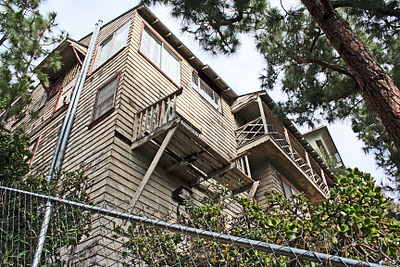
Only recently however did I discover that there's a place in my own neighborhood known locally as the Haunted House (that's it above). The actual address is 5672 Tryon Road, and its owners seem to have abandoned it about a decade ago, which is surely a mystery in itself. Who abandons a house in L.A.? Even if it's one that looks like it belongs in the swamplands?
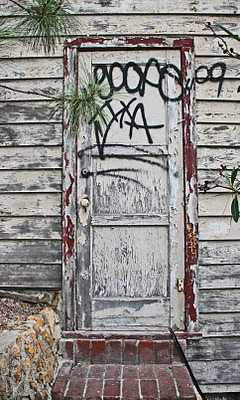
It's at the top of a flight of 150 steps, the kind you get in some parts of LA, here officially named Saint Andrews Walk (no apostrophe as far as I can tell). This is a pretty swank part of the neighborhood, far swankier than the part I live in. Across from the steps is a vast, much crenelated house that used to belong to Nicolas Cage.
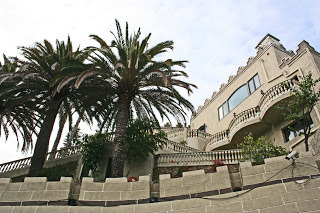
But Saint Andrews Walk is less than swank, a place which, according to an article by Adam Kear in a recent Oaks newsletter, "is a favorite hangout for drinking, drugs, and other nefarious activity. Tagging, litter, and loud late night noise are a continuing problem."
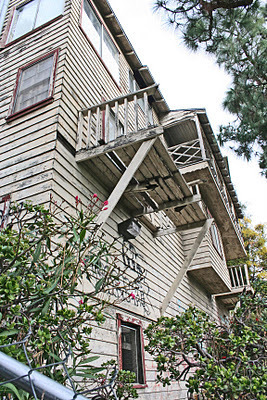
To be honest I don't walk down Saint Andrews Walk very often – I'd lived in and walked around the area for a few years before I even knew it was there. The problem with walking down 150 steps is that at some point you tend to have to walk up them again, but I do use the stairs once in a while, and I console myself with the knowledge that I can break the ascent halfway up where there's a level area, a bench and a kind of balustrade. This however seems to be ground zero for bad, and possibly criminal, behavior: arrests have been made.

I've only ever seen a few people hanging out there, and I've never witnessed criminality, but there's plenty of evidence that at other times some drinking, drugging and partying must go on. Litter gets strewn on the steps, bottles are thrown into neighboring gardens, and there are some low-level graffiti that are very almost certainly not art, though this one might be construed as an example of psychogeographic mapping.
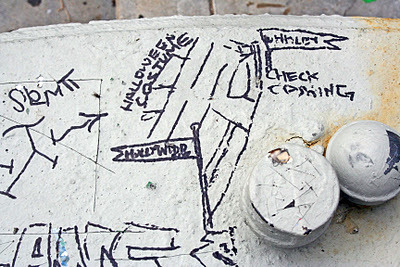
The bad behaviour all looks fairly small time, but even so it must be hell to have it happening on the other side of your garden fence. Kear reckons that the "Haunted House" is "the major reason problems on the stairs have continued. It is a classic case of 'broken windows' theory. It sends a message that no one is watching and no one cares: just inviting criminal activities on the stairs." I don't know enough urban theory to be sure if this is true or not. But it's an intriguing idea, isn't it, that people are so attracted to haunted houses? You might think that sinister, neglected, ruined, potentially dangerous houses would repel people, but in fact people, people just like us, in fact us, we're inexorably drawn to them.
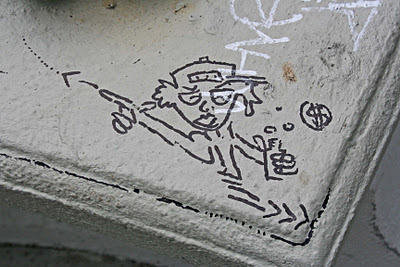
I'm assuming the people who hang out on Saint Andrews Walk are young, because once you reach a certain age, drink, drugs, partying and other nefarious activities are more enjoyable when done in private. Tagging and graffiti, on the other hand, are obviously public forms.

When MOCA had its street art exhibition, lots of graffiti appeared in the streets around the museum. Director Jeffrey Deitch was blamed. His exhibition was just too darned inspiring. This seems just slightly unfair. Would you blame the director of the Van Gogh Museum if somebody looked at the pictures and then cut off his ear? Well maybe you would. Anyway, both the graffiti and the outcry seemed entirely predictable.
Now, I discover that Jeffrey Deitch lives right in the area, barely stumbling distance from Tryon Road and Saint Andrews Walk, but his house remains free of grafitti. It's free of ghosts too, I think, though Cary Grant was once a resident, and in the picture it does look as though the ghost of Jesus is lurking on the wall behind him.

During the street art exhibition Deitch got into further trouble because he painted over a mural he'd commissioned for the side wall of the gallery, from the artist Blu. The art was too "political" apparently. A supporter of Blu claimed to have been at a party in Deitch's house, and painted this on the bathroom wall:

I suppose its heart is in the right place, but it looks pretty fake to me: that T looks all wrong, just a layer of Photoshop, right? And the lack of apostrophe? Well, that could be real or feigned illiteracy - who can tell anymore? But as a matter of fact I think Jeffrey Deitch would have a much swankier bathroom than the one in the picture. He commissioned the artist Richard Woods to turn one room of the house into a "super-Tudor Pop environment," so that he can do his partying in private. Well you would, wouldn't you?


Published on November 25, 2011 20:21
November 23, 2011
A WALK ON THE MORE THAN WILD SIDE
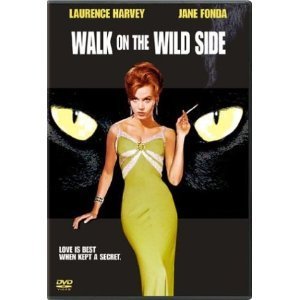
A couple of posts back I wrote about walking along various streets named Lexington, the one in Manhattan being mentioned by Lou Reed as a place to wait for "the man," where it meets 125th Street in Harlem.
I said that my own wanderings along the Lexington Avenue here in Hollywood had been very tame. Now I'm not sure if I was lucky or unobservant, or just there at the wrong (or right) time.

There was a murder on Lexington last Thursday night at about ten pm, near to where it crosses Gower Street. A "sex worker" named Nathan Vickers (that's her above, also known as Cassidy or Cassie), a transgender prostitute, was shot and killed, apparently by a homeless man on a bicycle. Yep the street folks of LA may not have homes, but bikes and semi-automatic weapons they do have.
The murder was a rarity, and a shock, but according to the LA Times the Lexington/Gower area "has drawn sex workers for more than a decade, most of them transgender women from Mexico and Central America. They are often seen walking small dogs." They found someone named Laura who'd been a streetwalker on Lexington for 20 years.
Who knew? Well plenty of people, obviously, but not me, though when I started thinking about it I realized that Lexington is only one block north of Santa Monica Boulevard which is indeed the place you'd more usually expect to see trannie hookers.

That was where, in 1997, Eddie Murphy picked up transsexual Atisone 'Shalomar' Seiuli before being picked up himself by the cops. His story was that he was fascinated by transsexuals and transvestites, felt bad for them, and he picked them up, talked to them, before giving them money to help them out. Who am I to doubt the word of Eddie Murphy?
The folks who live around Lexington seem to be less sympathetic. The Times found an anonymous neighbor who said, "I wish to heck that the cops would do something about it. They are parading notoriously, outrageously, and the cops don't do nothing about it. There is a good doughnut shop nearby but I am dissuaded from going over there because who wants to be around that?" You can see his or her point.
Not the least curious thing about living in Hollywood is that you soon get quite used to seeing transgender or at least transvestite prostitutes walking the streets. More than once, driving to the airport down La Brea, very early in the morning, I've seen one or two teetering across the road in their stripper heels. I try to imagine the night they must have had, then I reckon it might be better not to.
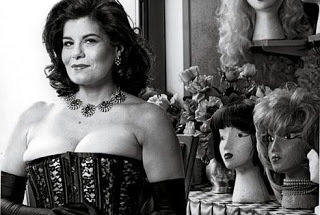
When I lived in New York I would occasionally be at the same parties as Veronica Vera, an interesting woman who's CV includes being a Wall Street trader and a model for Robert Mapplethorpe. Somewhere along the line she made an abrupt and canny career move and set up Miss Vera's Finishing School for Boys Who Want to Be Girls, a self-explanatory name, though the notion is that she's there to help out guys who want to express their feminine side, rather than become streetwalkers.

Walking apparently is the hardest part of looking convincingly feminine. Veronica Vera runs a class called "Amazing Grace: How to Walk, Sit and Pose in High Heels" which apparently is attended by some woman as well as men. She says, "Men plant their feet firmly on the ground and take control of the earth. Walking in high heels lifts us above. It fosters a dancing movement that's a flow rather than a pounce. It's a little more Zen, and that adds beauty." Much needed down on Lexington right now, I imagine.
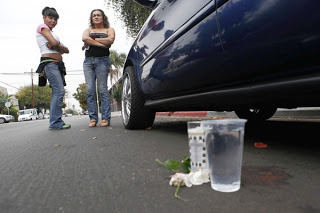 (Photo by Arkasha Stevenson, for the Los Angeles Times)
(Photo by Arkasha Stevenson, for the Los Angeles Times)
Published on November 23, 2011 14:57
November 15, 2011
WALKING THE MELANCHOLY BEAST
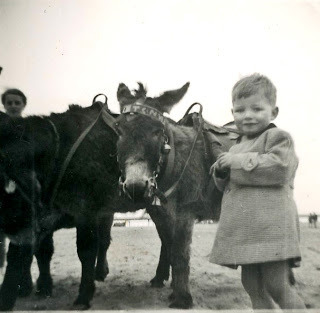
And speaking of melancholy, there was a moment (rather a long time ago now) when I considered writing a book to be titled "The Seaside In Winter." The idea was that I'd buy a VW camper and spend the three months of the British winter going around the coast, walking through all the deserted, windswept, out of season holiday resorts, waxing lyrical about the pleasures of abandonment, savoring the bleakness, the loneliness, the intense melancholy that would only end with the arrival of spring. Unless of course I ended it somewhat sooner than that, by my own hand, because I couldn't stand it anymore, and I'd be found slumped over the wheel of the van, in a parking lot next to some rotting rollercoaster. I could see how this would make for a very satisfying last chapter (presumably written by someone else).
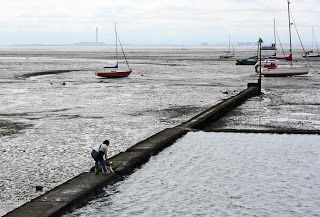
Part of the idea was that these seaside resorts, which in the summer are dedicated to leisure and fun, would in the winter reveal their true dark, depressing, despairing nature. And of course, I would probably have argued that this dark, depressing, despairing nature actually shows through pretty well even in the very middle of summer.

Well the book was just another one of those great books that never got written. And these days I think it was probably good for my mental health that I never even attempted the project.
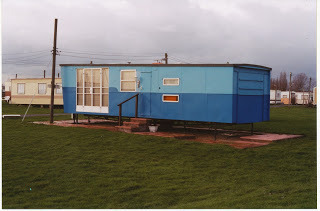
My family apparently believed in the seaside. As I grew up there were day trips to Skegness, Bridlington, Cleethorpes, then weeks away in Bognor, Great Yarmouth, even Newquay. In retrospect I don't know why my parents bothered. They never seemed to enjoy themselves very much, and in consequence I enjoyed myself even less. There was also always the suggestion that they'd come all this way, put in all this effort, just for me; which made the whole thing complete torture.
I think one of the problems was that my parents weren't great doers. They didn't like to do much of anything, and certainly not the kind of things that people typically do at the seaside, whether it be swimming or going on the Ferris wheel, visiting zoos or fun houses or playing crazy golf. Mostly, as I recall, we just walked up and down the prom, often with my mother complaining there was nothing to do except walk up and down the prom.
I have in fact inherited some of this tendency not to want to do things, though I have fought hard against it. (You want a round of crazy golf? Sure, you bet!) But maybe it's part of what turned me into a writer – into an observer rather than a participant. What I do have, which my parents seemed not to, is the ability to take pleasure in small things: I'm more than happy simply to walk up and down the prom. This is my idea of something to do rather than nothing.
When I stopped going on holiday with my parents they continued to go away to the seaside and I would receive sad postcards, such as the one below, that made me even more glad not to be on holiday with them.
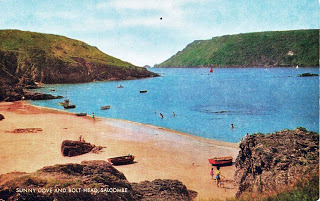
Martin Parr's book Boring Postcards beautifully captures the agony of the English at play: grey seaside gardens, boating lakes, caravan sites that look like internment camps. Of course it's laughable that people would think these were places where you might have fun, but the heartbreaking thing is that at the time we knew no better place to go to have fun.
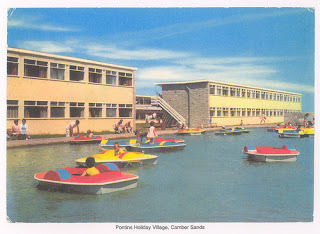
Since I now live in LA, I supposedly have easy access to the ocean: Santa Monica and the Pacific are just 15 miles away, although on the wrong afternoon it can take considerably longer to drive to Santa Monica than it used to take my dad to drive us to Skegness. But sometimes I do go to the California coast for a day or a weekend, to Huntingdon Beach perhaps where this picture was taken:
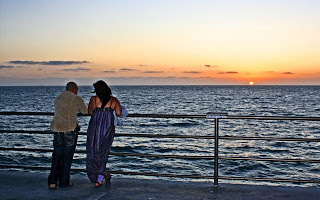
I kid you not, this is a photograph I took myself, it isn't a postcard. I actually saw these two people as I was walking on the pier at sunset and it really, really did look that. Perhaps you would expect nothing else from California, and I'm certainly not going to complain about the "picture postcard" aspect of it, but the fact is, at moments like that I actually experience a profound, nostalgic longing for the bleak English seaside. You bet I do. And when I'm back in England it seems to have become a habit to visit some more or less windswept bit of the Essex coast: Canvey Island, Southend, and on my last trip Jaywick.

People have been telling me about Jaywick for years, describing it as weird, gloomy, vaguely threatening, all the things I love. The place was built in the 1930s as a holiday resort for London's Eastenders, but according to a recent survey, with the title "Indices of Multiple Deprivation 2010," Jaywick is now the most deprived place in England. Of course you can judge these things in various ways. The survey used statistics for income, employment, health, disability, crime and living standards; and no doubt the place is full of poor, sick unemployed people. Even so, if the vast numbers of caravans are any indicator, a lot of people still want to be there, at least for part of the year.

I always find caravan sites gloomily appealing, but in Jaywick it's the houses that are truly compelling. Partly it's their smallness. Some of them are absolutely minute, built as holiday chalets, as places where you didn't do much more than sleep. Now people live in them full time. And some of the dwellings do show signs of desperate living, houses that have been smashed up, in some cases burned out. On the other hand there's plenty of evidence of house-proud owners keeping up their homes and gardens in beautifully eccentric ways. In some cases you can find examples of the two elements right next to each other, which admittedly must be tough on the house-proud. The received wisdom is that the house wreckers will eventually prevail, but I wouldn't give up all hope.
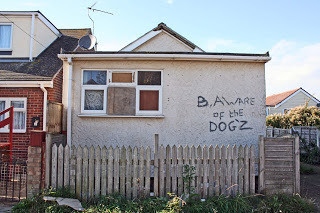
The beach and the air seemed clean enough, there's the promise of "renewal," and there was even an art exhibition in the Martello tower. And sure there were some dodgy characters walking the streets: a word to the wise, if you want to keep up a veneer of respectability do not walk down the street with a can of lager in your hand and stop to rifle through every litter bin you pass. But I don't know that the Jaywick guys looked any dodgier that the ones I see every time I walk along Hollywood Boulevard.

If I ended up living in Jaywick I certainly wouldn't think my life was a disaster. And the fact is, a lot of people do end up living at the seaside one way or another. Which brings me, a tad free-associatively, to Aleistair Crowley, who ended up, not in Jaywick, but in Hastings for the last two years of his life, keeping up a surprising thick veneer of respectability. Iain Sinclair, of course, has a place in Hastings now too.
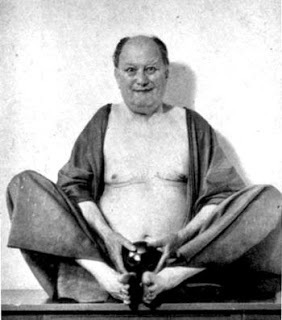
I must say that to the limited extent I ever think about Crowley at all, I never imagined him as much of a walker. And yet here he is in Chapter 67 of his Confessions: "When one walks, one is brought into touch first of all with the essential relations between one's physical powers and the character of the country; one is compelled to see it as its natives do. Then every man one meets is an individual. One is no longer regarded by the whole population as an unapproachable and uninteresting animal to be cheated and robbed. One makes contact at every point with every stranger." Whether one actually wants to make contact at every point with every stranger, in Jaywick or on Hollywood Boulevard, or in fact anywhere else, remains open to debate.

Published on November 15, 2011 16:30
November 11, 2011
BENNETT VERSUS SEBALD
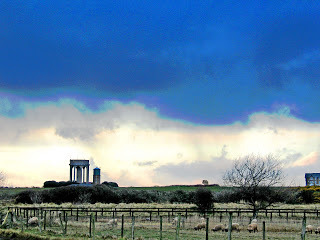
And speaking of walking and cruising (as I was a few posts back), there's a curious piece in Alan Bennett's collection Untold Stories, titled "Common Assault" in which he describes being on holiday in Ladispoli in Italy with his boyfriend and being attacked by a group of local youths, while out walking at night. It is a serious assault, as well as a common one: metal pipes and head injuries (Bennett's) are involved.
The local Italian police are no help at all and they assume, quite incorrectly, that Bennett was out trying to pick up young men, and he got what they (the police) thought he deserved.
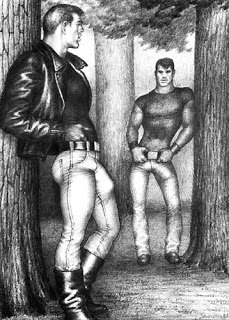
Bennett is especially affronted by this assumption since, as he says, "I have never been able to cruise and have never had much inclination to do so, though seeing it as a definite shortcoming, one of several masculine accomplishments I have never been able to master ... It was partly that, never feeling I would be much of a catch, I saw no point trawling the streets for someone who might feel differently. And then, too, I was quite hard to please."
Well, these all strike me as perfectly good reasons not to go walking the dangerous streets of foreign cities at night looking for sex, though as I saw with my friend Martin, it's obviously perfectly possible to do it in broad daylight in familiar territory, though I can see that might not be quite as exciting.
There is perhaps also the possibility that the youths attacked Bennett simply because he "looked gay" but since robbery was also involved, they may well have been entirely unprejudiced attackers who'd have robbed anyone out walking who looked vulnerable, gay, straight or bi.
I haven't been able to find a picture of Alan Bennett walking, though there is this one of him standing in the Yorkshire landscape, and I suppose he must have done at least a little walking in order to get there:

In the course of the book Bennett also offers his opinion on W.G. Sebald. He is not besotted. He writes, "… the contrivance of it, particularly his un-peopling of the landscape never fails to irritate. 'It was already afternoon, six in the evening when I reached the outskirts of Lowestoft. Not a living soul was about in the long street.' In Southwold 'everybody who had been out for an evening stroll was gone. I felt as if I were in a deserted theater.' Maybe East Anglia is like this ... but Sebald seems to stage-manage both the landscape and the weather to suit his (seldom cheerful) mood."

Well I do take Bennett's point. I've always wondered what happened on those occasions when Sebald went out for a walk, found the sun shining and the streets filled with throngs of happy people and laughing children. I suppose the simple answer is that he went home with nothing to write about. Or he went home and wrote a "fictionalized version" which, of course, as an artist he was perfectly free to do.

My own suspicions about Sebald's stage-management comes from knowing that he used to drink in a pub Southwold called the Crown. I only went there a couple of times, and it seemed to be full of full of media folk up from London, drinking Chardonnay, savoring the local Suffolk "fayre" and talking about their latest projects. Sightings of Melvin Bragg and Michael Palin were reported. There are plenty of gloomy, chilly pubs in and around Southwold that would surely have been better-suited to Sebald's professed melancholy.
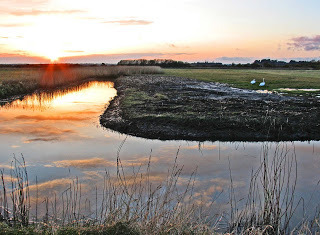
On the other hand, to give him his due, I think it's perfectly possible that some of Sebald's descriptions of the unpopulated East Anglian landscape, and even of Southwold, are literally true, and do stick to the letter of what he saw, of what anybody might see. These empty places do, of course, make cruising an extraordinarily pointless exercise.
The pictures accompanying this post were taken a few years back on my last night in Suffolk. I had owned a cottage there and I was finally selling up to live full time in Los Angeles, and I took a final long walk around Southwold, through the town, down the seafront, along the river and back. The streets and roads, the beach, and certainly the caravan parks, were completely deserted, and I did indeed feel a great wash of yearning, though not entirely unpleasant, melancholy. I was not, however, for a moment, tempted to go for a drink in the Crown.
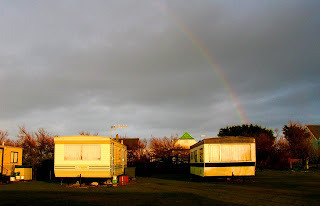
As a matter of fact I didn't find it all that much easier to find a picture of Sebald walking than I did Alan Bennett, though for what it's worth, here's this one:
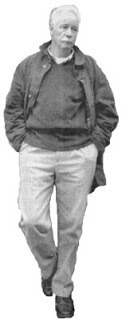

Published on November 11, 2011 06:00
November 6, 2011
STUMBLING IN THE GRAVEYARD
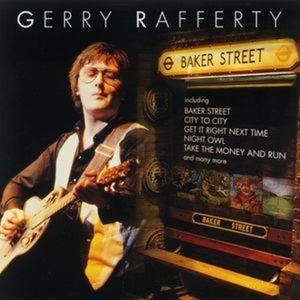
In London, I lived for a while in a flat just off Baker Street. Every time I walked to or from the tube I found myself singing the Gerry Rafferty song "Baker Street," complete with that famous saxophone hook. When I was walking with other people we'd sing it in unison, every time. It got really annoying but we couldn't stop doing it, at least not till I moved out of the flat.
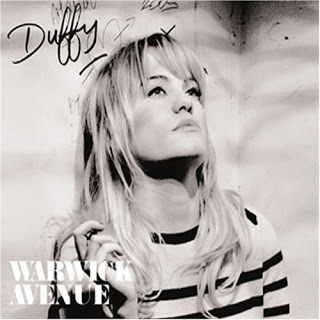
Then I lived in Maida Vale, and my local tube was Warwick Avenue. In fact I'd lived there for years before Duffy had a hit with a song "Warwick Avenue," and I never really liked the song all that much but I know there were many who did, and I was well aware there were people in the world who knew Warwick Avenue much better as a song title than as a geographical location or as a place to live.

Here in L.A. there's a street called Lexington, an ordinary enough street that I walk down once in a while, and every time I do I start singing those lines, "Up to Lexington 125, Sick and Dirty More Dead than alive" from the Velvet Underground's "Waiting for the Man." I know, of course, that the song refers to Lexington Avenue in Manhattan, not in L.A., but that doesn't deter me from singing it to myself. For that matter there's also a Lexington Street in London.
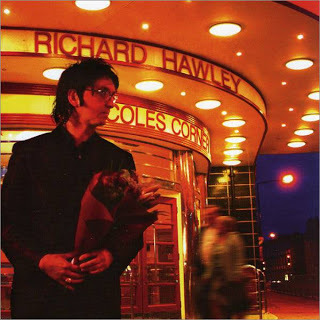
Thanks to Richard Hawley several Sheffield locations have now been celebrated in song: Coles Corner, Truelove's Gutter, Lady's Bridge. For years I used to walk by Lady's Bridge, to catch my bus in what had once been Truelove's Gutter, but was then known as Castle Street. On my recent trip to Sheffield I spotted this wonderful tiled building, right beside Lady's Bridge.
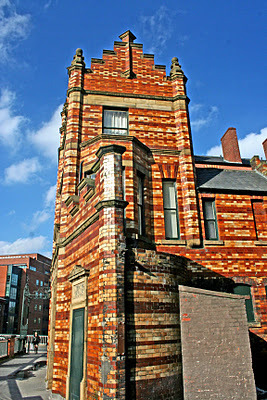
Looking at it now, it seems to me that it's one of the most wonderful buildings in Sheffield, but I scarcely noticed it in all the years when I caught my bus there. As my pal Steve said, if a building with tiles like that was in Barcelona it would be regarded as an architectural treasure.
But essentially when I think of Sheffield landscapes and Sheffield music, I tend to obsess about "Sensoria" by Cabaret Voltaire. I love that industrial funk, and the lyrics, and especially that line "In hard times, hard thrills." The video was directed by Peter Care, and I assume dates from 1984 when the single was released, though I suppose it could have been slightly later. It looks like this:
I'm not sure I ever saw the video in the 80s when it was actually made, but thanks to youtube it's now easy access, and although I don't know exactly where every scene was shot, it seems to be various places in the east end of Sheffield. Those cooling towers are now long gone, and much missed by some, but for me it's that strange, ancient little chapel that's so fascinating. It's the Hill Top Chapel on Attercliffe Common. And since I was in Sheffield for the weekend I decided to seek it out.
The chapel dates from 1629 and it's had a chequered history, opening and closing as the population of Attercliffe grew or shrank, changing its size and shape, superceded for a while by a much larger church but then that new one was destroyed in the Second World War. The chapel was declared redundant in 1985 – just after the Cabaret Voltaire video was shot - but then it was later put back into service and is apparently now used for "prayer … day retreats … and RE and local history studies by local schools."
The place was easy enough to find, but it wasn't especially welcoming. There were two locked gates denying access to the church yard, but the surrounding wall was low, there weren't even any keep out signs, and in any case I understand that trespass is a civil offence in Britain, not a criminal one, and so I popped over the wall for a look.
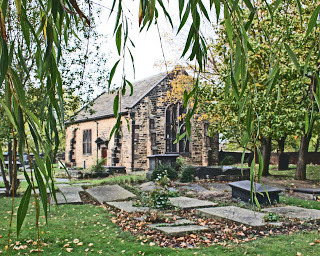 The first thing that strikes you is that in the video the chapel seems to be absolutely in the middle of nowhere, on a completely desolate, blighted landscape, but now it seems to be surrounded by mature trees. I suppose they could have grown up since the video was made, but I do wonder if it was clever camera angles that made the place look so isolated and bleak.
The first thing that strikes you is that in the video the chapel seems to be absolutely in the middle of nowhere, on a completely desolate, blighted landscape, but now it seems to be surrounded by mature trees. I suppose they could have grown up since the video was made, but I do wonder if it was clever camera angles that made the place look so isolated and bleak.In any case it's not so isolated now. A great deal of stuff has sprung up around the chapel: the Don Valley Stadium, the Sheffield Arena, an ice rink, the Meadowhall Retail Park, and right behind the chapel is a light industrial estate.
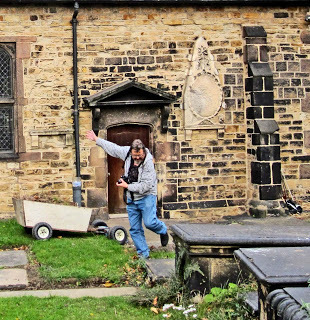
And just to prove that I really went there, above is a picture of me (pal Steve took the picture) outside the chapel, and although I may look as though I'm dancing, a la Cabs, in fact I'm trying to keep my balance having tripped over the edge of a gravestone, although looking at it another way, I suppose that might be considered a form of dance.
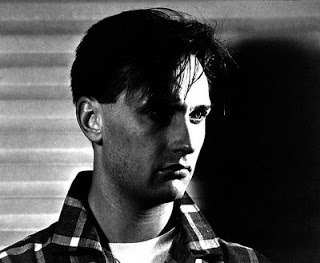

Stephen Mallinder, of Cabaret Voltaire, (that's him above, during and after) has now become a very hip academic. In 2007 he wrote an essay titled "Sheffield is Not Sexy" – and I'm really not sure how many layers of irony there are in that title, if any. In the essay he reveals that before he was a pioneer of industrial music he was a lover of reggae and soul, and he writes that on his way to school every day he passed the Mojo Club - the legendary and slightly disreputable Sheffield venue, where it seems EVERYBODY played – Howlin' Wolf, Hendrix, the Stones, the Beatles. I passed it on my way to school every day too.

Mallinder writes, specifically of soul music, though it surely has a much wider context, "Soul music, through its global dissemination, had created a community that reached from California to South Yorkshire through the shared experiences of consumption and dancing." Hey, Stephen, I'm trying to keep up my part of the bargain, living in LA. dancing in the graveyard in Attercliffe, even when I'm only trying to walk.

Published on November 06, 2011 07:44
DANCING IN THE GRAVEYARD

In London, I lived for a while in a flat just off Baker Street. Every time I walked to or from the tube I found myself singing the Gerry Rafferty song "Baker Street," complete with that famous saxophone hook. When I was walking with other people we'd sing it in unison, every time. It got really annoying but we couldn't stop doing it, at least not till I moved out of the flat.

Then I lived in Maida Vale, and my local tube was Warwick Avenue. In fact I'd lived there for years before Duffy had a hit with a song "Warwick Avenue," and I never really liked the song all that much but I know there were many who did, and I was well aware there were people in the world who knew Warwick Avenue much better as a song title than as a geographical location or as a place to live.

Here in L.A. there's a street called Lexington, an ordinary enough street that I walk down once in a while, and every time I do I start singing those lines, "Up to Lexington 125, Sick and Dirty More Dead than alive" from the Velvet Underground's "Waiting for the Man." I know, of course, that the song refers to Lexington Avenue in Manhattan, not in L.A., but that doesn't deter me from singing it to myself. For that matter there's also a Lexington Street in London.

Thanks to Richard Hawley several Sheffield locations have now been celebrated in song: Coles Corner, Truelove's Gutter, Lady's Bridge. For years I used to walk by Lady's Bridge, to catch my bus in what had once been Truelove's Gutter, but was then known as Castle Street. On my recent trip to Sheffield I spotted this wonderful tiled building, right beside Lady's Bridge.

Looking at it now, it seems to me that it's one of the most wonderful buildings in Sheffield, but I scarcely noticed it all the years I when caught my bus there. As my pal Steve said, if a building with tiles like that was in Barcelona it would be regarded as an architectural treasure.
But essentially when I think of Sheffield landscapes and Sheffield music, I tend to obsess about "Sensoria" by Cabaret Voltaire. I love that industrial funk, and the lyrics, and especially that line "In hard times, hard thrills." The video was directed by Peter Care, and I assume dates from 1984 when the single was released, though I suppose it could have been slightly later. It looks like this:
I'm not sure I ever saw the video in the 80s when it was actually made, but thanks to youtube it's now easy access, and although I don't know exactly where every scene was shot, it seems to various places in the east end of Sheffield. Those cooling towers are now long gone, and much missed by some, but for me it's that strange, ancient little chapel that's so fascinating. It's the Hill Top Chapel on Attercliffe Common. And since I was in Sheffield for the weekend I decided to seek it out.
The chapel dates from 1629 and it's had a chequered history, opening and closing as the population of Attercliffe grew or shrank, changing its size and shape, superceded for a while by a much larger church but then that new one was destroyed in the Second World War. The chapel was declared redundant in 1985 – just after the Cabaret Voltaire video was shot - but then it later was put back into service in and is apparently now used for "prayer …day retreats … and RE and local history studies by local schools."
The place was easy enough to find, but it wasn't especially welcoming. There were two locked gates denying access to the church yard, but the surrounding wall was low, there weren't even any keep out signs, and in any case I understand that trespass is a cilil offence in Britain, not a criminal one, and so I popped over for a look.
 The first thing that strikes you is that in the video the chapel seems to be absolutely in the middle of nowhere, on a completely desolate, blighted landscape, but now it seemed to be surrounded by mature trees. I suppose they could have grown up since the video was made, but I do wonder if it was clever camera angles that made the place look so isolated and desolate.
The first thing that strikes you is that in the video the chapel seems to be absolutely in the middle of nowhere, on a completely desolate, blighted landscape, but now it seemed to be surrounded by mature trees. I suppose they could have grown up since the video was made, but I do wonder if it was clever camera angles that made the place look so isolated and desolate.In any case it's not so isolated now. A great deal of stuff has sprung up around the chapel, the Don Valley Stadium, the Sheffield Arena, an ice rink, the Meadowhall Retail Park, and right behind the chapel is a light industrial estate.

And here just to prove that I really went there, above is a picture of me (pal Steve took the picture) outside the chapel, and although I may look as though I'm dancing, a la Cabs, in fact I'm trying to keep my balance having tripped over the edge of a gravestone, although looking at it another way, I suppose that might be considered a form of dance.


Stephen Mallinder, of Cabaret Voltaire, (that's him above, during and after) has now become a very hip academic. In 2007 he wrote an essay titled "Sheffield is Not Sexy" – and I'm really not sure how many layers of irony there are in that title, if any. In the essay he reveals that before he was a pioneer of industrial music he was a lover of reggae and soul boy, and he writes that on his way to school every day he passed the Mojo Club - the legendary, and slightly disreputable Sheffield venue, where EVERYBODY played – Howlin' Wolf, Hendrix, the the Stones, Beatles. I passed it on my way to school every day too.

Mallinder writes, specifically of soul music, though it surely has a much wider context, "Soul music, through its global dissemination, had created a community that reached from California to South Yorkshire through the shared experiences of consumption and dancing." Hey, Stephen, I'm trying to keep up my part of the bargain, dancing in the graveyard in Attercliffe, even when I'm only trying to walk.

Published on November 06, 2011 07:44
November 1, 2011
OFF THE SHELF, ON THE MAP
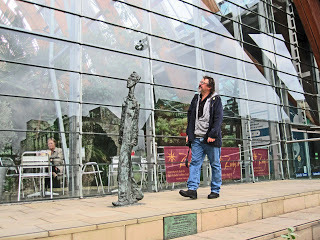
So, I have been to Sheffield and walked (very roughly) in a circle as part of the Off The Shelf literary festival, accompanied by an "audience" of 25 or so fellow (paying) pedestrians. Odd to be paid to walk. Odder still that people would pay to walk with me.
The group was limited to that number, which at first I thought was very low, but in the end I reckoned it was about right. The organizers said they could have sold out the event ten times over, which was very flattering, but the idea of walking the streets of Sheffield with 200 plus people in tow sounds like a recipe for absolute chaos. Keeping twenty odd waifs and strays in line, getting them across roads, stopping them wandering into traffic, keeping them within hailing range, was tricky enough, and I was glad I had a couple of wranglers from the festival, Lesley and Emma, to keep everybody in check (myself included).
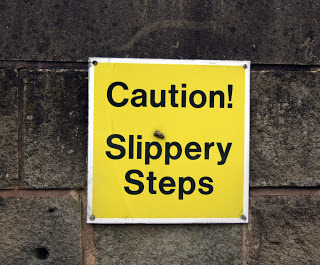
Ultimately the task I'd set myself (strange as it might seem) was to do a compare and contrast between Sheffield and Hollywood. The differences hardly needed to be labored, but finding the similarities was very instructive and actually much easier than you (or even I) would imagine.
The walk began and ended at the Showroom Café Bar, which happens to be right opposite an endearingly eccentric piece of architecture, designed by Nigel Coates, consisting of four large, metal-clad forms, that are variously described as looking like drums, curling stones or crucibles.
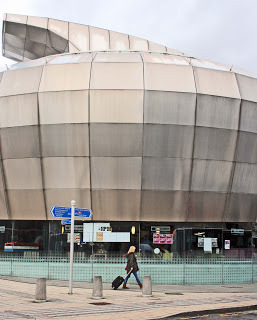
The building originally housed a rock and roll museum, officially the National Centre for Popular Music, which I visited in the short period it was open. Understandably, the founders wanted some local flavor, and so the museum contained a lot of memorabilia from local bands. My memory's a bit vague but I think there was a guitar that had belonged to Frank White, who was once Joe Cocker's guitarist, and I'm pretty sure there was another belonging to Richard Hawley. No doubt local bands such as ABC, the Human League, Cabaret Voltaire and Def Leppard featured too.
It was all interesting enough but it always seemed doubtful that hordes of music lovers would beat a trail to Sheffield to look at this stuff. And so it proved. The museum closed down after not much more than a year, and now it's the students' union for Sheffield Hallam University, and known as The Hub.
I really like the original building, since it seemed both fun and yet serious, and in that sense it resembles the Capitol Records building in Hollywood. The lesson I think is that architects can allow themselves to be playful when they're designing a building that has some connection with entertainment or showbiz. But when it comes to courthouses and city halls, for example, people demand something more poker-faced.
Sheffield seemed to be in the middle of a street art revival, as I suppose is much of the world. L.A. is currently awash with the stuff, both in and out of museums. In Sheffield the most ubiquitous was Kid Acne. Great name. His word pieces are all over the city, simple messages painted on the boards surrounding empty plots of land: "That'll Learn 'em," "Dust In the Giant's Eye," "Tha Knows," "You'll Get What You're Given," and so on. He was also having a show in the Millenium Galleries: I was particularly taken with his "stabby women."
[image error]
Not least of the problems of street art is that it has to make an immediate impression, but then it can hang around for a surprisingly long time. Just how many times can you read "That'll Learn 'Em" and still think it's interesting? Colin Drury, a columnist at the Sheffield Star, directed me towards an artist rejoicing in the name of Phlegm, whose work is certainly more complex, and one imagines more enduring, though of course endurance may not be what we're looking for in street art.
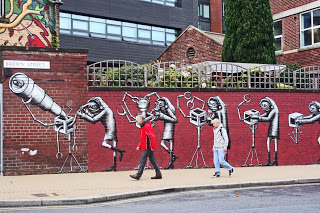
I did manage to find a Sheffield equivalent of the Hollywood Sign (well, sort of), a large banner hung on a wall beside a parking lot, saying "Welcome to Sheffield" though it seemed that whatever direction you were coming from, you'd have been in Sheffield for some time before you received this welcome.

The local people on the walk found this sign every bit as mystifying as I did, and some said they'd never noticed it before, which made me feel pretty good. I knew it was never going to be easy to show the people who lived in Sheffield something that was new to them.
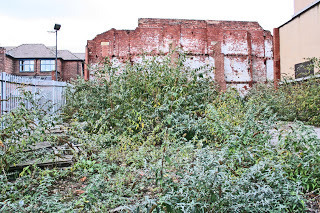
I also had a spiel about the ways in which, given a little neglect, benign or otherwise, the natural world has a way of reasserting itself in the built environment. I talked about the way creepers and palm tress spring up around the Hollywood Freeway, and there in Sheffield we saw the way that some unrealized developments had left empty patches of land around the city center, patches on which jungles of greenery were now thriving.
Some of the things we saw en route were genuinely ephemeral. We walked past the St. Marie's Cathedral (Temporary), relocated in a storefront while the actual cathedral is being renovated.
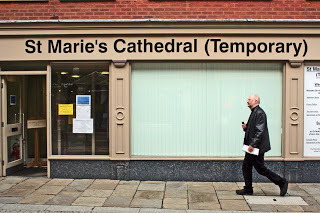
At one point a young man in full vampire drag cycled by us. We stared at him, he stared at us, then said by way of apologetic explanation, "Halloween." We had already guessed.

And it so happened the fair was in town. There was a helter skelter right in the middle of Fargate, the main pedestrian shopping street, and who can read the words "helter skelter" without thinking of Charles Manson and the L.A. murders committed in his name by his "family"?
[image error]
Similarly, a little way up the road, outside the City Hall (the place where - a lifetime ago as it now seems - I saw Led Zeppelin, Pink Floyd and indeed Tony Williams' Lifetime) they'd set up some vomit-inducing fairground ride called Freak Out, and I can certainly not read the words "freak out' without thinking of Frank Zappa, the man whose work gave me a crash course in American culture. His mentions of Howard Johnson motels, rancid Budweiser, Cel-Ray, the El Monte Legion stadium and so on, suggested that there were things to know about America that I wasn't going to find on a university American studies course.
I was put up in the Hilton hotel in a part of Sheffield I'd never even heard of, a regenerated area now known as the Victoria Quays. I think this used to be called the Sheffield canal basin, though as I grew up in Sheffield I didn't even know there was a canal in the city. The whole area is now wonderfully cleaned up and pleasant and terrific place to do a certain kind of post-industrial walking.
[image error]
I assume the area got its new name because it's more or less where the old Sheffield Victoria station used to be. I certainly went to the station a few times as a kid, at least once in the company of trainspotters. I never really "got" trainspotting, though I did develop an unprofessional enthusiasm for trains, tracks and railway buildings, which remains with me.
[image error]
I knew the station had been gone for a good long time, but I even so I walked around the area looking for signs of it. I could find hardly any, could barely see where it had stood. The station hotel remains, and I knew it had to be adjacent to that, but it took quite a stretch of the imagination to picture where the station had once been.
The area had changed out of all recognition, but the gentrification wasn't absolutely complete or permanent. Little pockets of mess and decay continued to show through, and I wasn't entirely sorry to see them. The railway arch below is actually part of a recycling facility, so I suppose you could argue that even this is environmentally friendly.

Although, on my walk, I was happy to talk about the Sheffield I knew growing up, I tried to avoid the "I remember when all this was fields" approach. However, my old Sheffield pal Steve, who was my tour guide, even as I was a tour guide for other people, next day took me along Prince of Wales Road, a route I used to know pretty well back in the day, and he pointed out that a large number of council houses had now been demolished because of defective mortar, and had never been replaced. This allowed him to say, "I remember when these fields were all houses." We both enjoyed that.
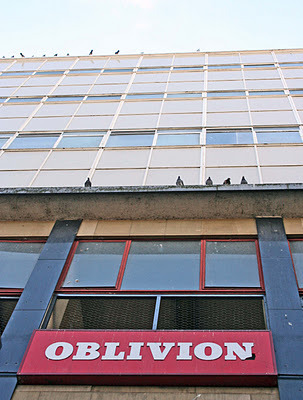

Published on November 01, 2011 16:45
October 11, 2011
WALKING THE EDGE
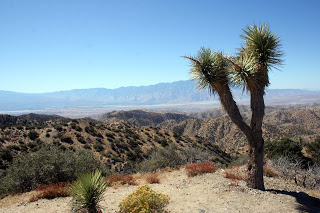
If I have a reservation about Gus Van Sant's "Gerry," (discussed elsewhere on this blog) it's that he, or his cinematographer, makes the desert look a little too picturesque. Of course, I'm not going to deny that the desert is visually beautiful, that's what first attracted me to it, and of course I love a broad stretch of unspoiled, pristine desert as much as the next man, and I'm very glad indeed that Death Valley or Joshua Tree survive as preserved patches of territory that are as close to "virgin" as we're ever likely to see, and of course they are meticulously "managed.". But the fact is, I also love a spoiled, less than pristine stretch of desert.
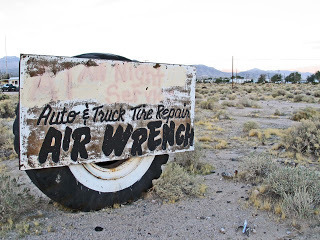
And when it comes to on-screen depictions of the desert I'm drawn to Werner Herzog's "Fata Morgana," his early "documentary" that traces an inscrutable journey down through the Sahara desert. Certainly the film does have some gorgeous desert imagery, including this shot of a little boy walking his fennec fox on a leash across the sand dunes.

But "Fata Morgana" also shows the desolate edges, the areas scarred by human activity, not least military and industrial. Herzog is smart enough not to simply revel in the beauty of ugliness, and I think he's not indulging in the pleasure of ruins either, but he does show us that the wrecked and the damaged may be every bit as compelling as the pristine.
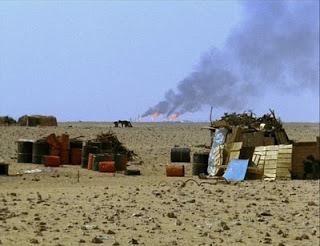
My own attitudes have changed over time. When I first started visiting deserts I wanted them clean and empty and devoid of human presence (well, any human presence except mine, naturally). And of course I still like those grand vistas of Joshua Tree and Death Valley, and I regularly go and walk in them, but on the way there I know I'll pass through some scrubby, frayed bits of desert, the outskirts of towns like Barstow, Boron or Baker, and I'll be drawn to deserted motels, abandoned houses, evidence of human presence as well as absence.
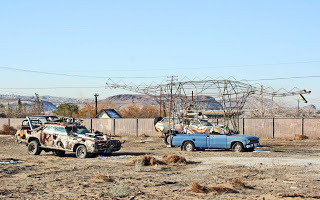
This has been on my mind a lot recently. I've been reading a book titled Edgelands by Paul Farley and Michael Symmons Roberts, a couple of British poets who go wandering around what the subtitle calls "England's true wilderness," the non-spaces that fail to appear either on topographical or mental maps: sewage works, parking lots, airports, scrap yards, and so on.
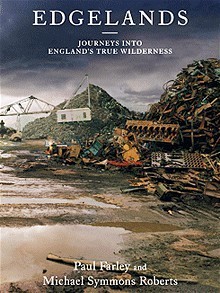
They write, "Somewhere in the hollows and spaces between our carefully managed wilderness and the creeping, flattening effects of global capitalism, there are still places where an overlooked England truly exists … complicated, unexamined places that thrive on disregard."
This is great stuff and certainly it doesn't apply only to England. And I don't the guys are just being perverse, like going to the Sistine chapel and admiring the floor. One of the most basic functions of writing is to point out things that otherwise might have been missed, and these guys do it royally.
The book also it made me realize that I have spent large chunks of my life walking in and admiring edgelands. For instance I love great Victorian railway architecture, the stations, the bridges, the engine sheds, but I'm actually more at home wandering along disused railway lines admiring those strange little shacks and huts that grow up alongside them.
[image error]
And one of the things I've realized is that not all edgelands are at the edge. Sometimes there can be junk spaces right in the middle of things. My favorite non-space in that sense is shown in the picture above, an alley right in the heart of Hollywood, that runs off Las Palmas Avenue, just below Hollywood Boulevard. It may have a name but I can't find it on any of the maps I've got. It goes down the side of Miceli's Italian restaurant, but as the sign indicates, it belongs to somebody else "Supply Sergeant" which is an army surplus store nearby. And of course the absolute joy of it is the precision with which somebody has measured, recorded, and sign-painted the dimensions of this otherwise thoroughly nondescript space.

Published on October 11, 2011 05:12
October 6, 2011
BACK IN THE HIGH LINE

While I was in New York I went to the High Line, a section of elevated railway that's now been converted or I dare say "repurposed," into a pedestrian precinct so that New Yorkers can stroll high above ground level and look down on the poor suckers beneath them. New Yorkers seem justifiably proud of it, and a lot of people do in fact walk there, but it's a very specific kind of walking, actually I think a form of promenading. People walking up and down, savoring the pleasure of walking, looking around them, checking each other out. Very old school.
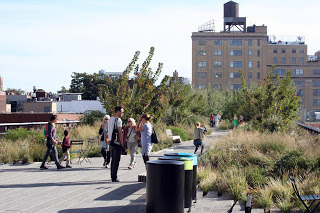
Of course, very few of the people walking the High Line are actually going anywhere, using it as a way of getting from A to B. That's not surprising. Citizens who actually need to get from the far western end of, say, 30th Street down to Gansevoort Street and the meat packing district are few and far between. So the place functions a kind of pedestrian theme park, a piece of reclaimed industrial territory, now decked out with walkways and exuberant landscaping, while keeping some of the old rails still visible.

One great thing, obviously, is that you're above the traffic, and therefore not confronted by manic drivers or deranged cyclists. There's even a section where people sit in a kind of amphitheater and gaze down at the traffic below; a surprisingly pleasurable activity.
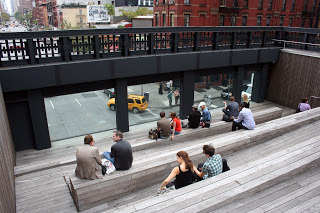
But even so, walking on the High Line isn't entirely different from walking the sidewalks of New York. The paths are extremely narrow in places and you can find yourself stuck behind a group of inconsiderate, slow-moving walkers just as you can on the street.
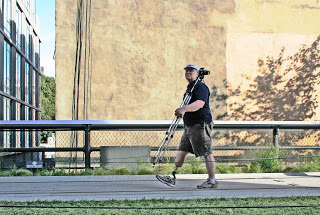
There are also some wooden loungers where people who are less committed to walking can sprawl back and display themselves to passing pedestrians. Did somebody suggest there might be one or two exhibitionists in New York? Well why not? People watching is always fun, and watching people who have actually set themselves up to be watched is a particular form of that fun.
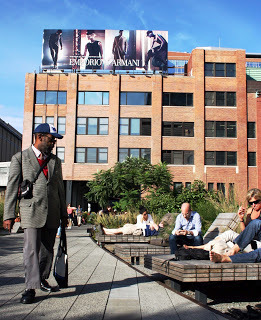
The High Line itself is suitably sylvan and park-like, but inevitably you look past the greenery and the pedestrian oasis, away towards the cityscape of the surrounding area. There are apartment blocks, new slithers of zesty modern architecture, old industrial buildings and the Hudson River is visible from certain places.
There are inhabitants who were formerly living thoroughly quiet private lives who now find gaggles of people walking past their window and staring in. No doubt some are royally pissed off about it. On the other hand, some of the newer developments seem to be designed specifically with passing pedestrians in mind. In certain places you can look right into some very expensive apartments and see just how much space the inhabitants have got, indeed how much space they've wasted – the true sign of Manhattan opulence.
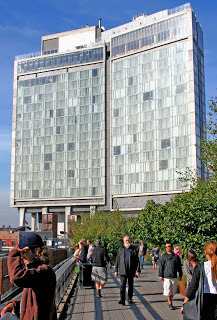
On the two days I went to the High Line, a building was being demolished very close to the southern end of the walkway. A guy in a demolition machine, one with caterpillar tracks and a single arm with what looked like a giant hole punch on the end, though I believe it's actually known as a hydraulic hammer, was doing the job all by himself.
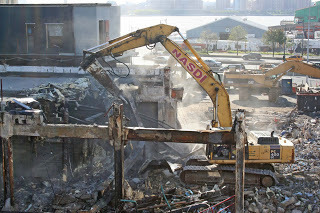
Smashing walls and roof was easy enough but then he encountered metal girders which were much harder to break down, though he always got there in the end. The whole process delivered quite an ear-bashing to the walkers on the High Line, and clouds of demolition dust rose up and billowed in our direction. The noise and the dirt were the kind of thing that you might think would threatened to spoil a walk. But it didn't. The walkers I saw absolutely LOVED it. We all paused in our walking, moved to the side of the High Line, pressed against the railing and stared down in absolute fascination, to see how one man could destroy a whole building.
It didn't spoil the walk, it absolutely MADE the walk. If I were designing a pedestrian theme park I'd make sure there was some industrial-scale destruction going on there; so much more fun than looking at the birds and the plants and the show offs on the wooden sun loungers.

Published on October 06, 2011 15:18
Geoff Nicholson's Blog
- Geoff Nicholson's profile
- 55 followers
Geoff Nicholson isn't a Goodreads Author
(yet),
but they
do have a blog,
so here are some recent posts imported from
their feed.






















